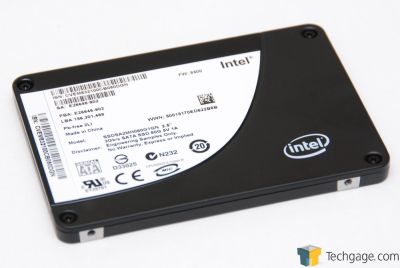From our front-page news:
When Intel first launched their X-25M SSD, no one knew what to expect. After all, although Intel is no newbie in the semi-conducter business, storage wasn't exactly their forte. All doubts were quickly put to rest though, as the X-25M (and then the SLC-based X-25E) blew away all expections. Somehow, Intel managed to take what we thought were lackluster memory chips (MLC), paired them with an unbelievable controller and as a result, delivered an SSD that offered the fastest random write speeds on the market, along with an incredible read speed. The problem at the time of launch was of course, the price.
As exciting as their SSD line-up is, it's about to get a lot better for various reasons. In today's announcement, Intel officially launches the market's first SSDs based on 34nm memory (previous were 50nm), along with some nice price drops that are sure to please many.
Although you'd imagine that a shrink like this would bolster performance, Intel says it won't in this case, except when testing them in specific ways (synthetic benchmarks). Since Intel can say it better than I can, here's a verbatim quote on their thoughts:
Compared to its previous 50nm version, the new Intel X25-M on 34nm offers decreased latency and faster random write Input/Output Operations Per Second (IOPS) than its 50nm predecessor. Specifically, Intel’s new SSD provides a 25 percent further reduction in latency, for quicker access to data, operating at 65-microsecond read latency compared to approximately 4,000 microseconds for an HDD. Random write performance has increased 2x for the 80GB and 2.5x for the 160GB to further separate the X25-M from other SSDs. By delivering up to 6,600 4KB write IOPS (8,600 IOPS for the 160GB) and up to 35,000 read IOPS, the X25-M continues to set the bar for SSDs, while leapfrogging HDDs which only operate at several hundred IOPS for traditional HDDs.
So there you have it. As for the pricing, Intel is "passing on cost reductions to its customers", and as a result, the 80GB model will sell for $225 in quantities of 1,000, while the 160GB model will sell for $440, also in quantities of 1,000. By comparison, when the original 80GB X25-M launched, it cost $595 to the consumer, so we're steadily moving in the right direction. We'll have a review of the 160GB model within the next few weeks, so stay tuned.
The Intel X25-M on 34nm flash is drop-in compatible to the current 50nm version and traditional hard disk drives (HDDs). Higher in performance and durability than an HDD, the lightweight and low power Intel X25-M can also help extend notebook battery life. Featuring the latest-generation native SATA interface with an advanced architecture employing 10 parallel NAND Flash channels, our high performing SSD is architected with powerful Native Command Queuing to enable up to 32 concurrent operations. Other features include low write amplification and a unique wear-leveling design for higher reliability and longer lasting performance.
As exciting as their SSD line-up is, it's about to get a lot better for various reasons. In today's announcement, Intel officially launches the market's first SSDs based on 34nm memory (previous were 50nm), along with some nice price drops that are sure to please many.
Although you'd imagine that a shrink like this would bolster performance, Intel says it won't in this case, except when testing them in specific ways (synthetic benchmarks). Since Intel can say it better than I can, here's a verbatim quote on their thoughts:
Compared to its previous 50nm version, the new Intel X25-M on 34nm offers decreased latency and faster random write Input/Output Operations Per Second (IOPS) than its 50nm predecessor. Specifically, Intel’s new SSD provides a 25 percent further reduction in latency, for quicker access to data, operating at 65-microsecond read latency compared to approximately 4,000 microseconds for an HDD. Random write performance has increased 2x for the 80GB and 2.5x for the 160GB to further separate the X25-M from other SSDs. By delivering up to 6,600 4KB write IOPS (8,600 IOPS for the 160GB) and up to 35,000 read IOPS, the X25-M continues to set the bar for SSDs, while leapfrogging HDDs which only operate at several hundred IOPS for traditional HDDs.
So there you have it. As for the pricing, Intel is "passing on cost reductions to its customers", and as a result, the 80GB model will sell for $225 in quantities of 1,000, while the 160GB model will sell for $440, also in quantities of 1,000. By comparison, when the original 80GB X25-M launched, it cost $595 to the consumer, so we're steadily moving in the right direction. We'll have a review of the 160GB model within the next few weeks, so stay tuned.
The Intel X25-M on 34nm flash is drop-in compatible to the current 50nm version and traditional hard disk drives (HDDs). Higher in performance and durability than an HDD, the lightweight and low power Intel X25-M can also help extend notebook battery life. Featuring the latest-generation native SATA interface with an advanced architecture employing 10 parallel NAND Flash channels, our high performing SSD is architected with powerful Native Command Queuing to enable up to 32 concurrent operations. Other features include low write amplification and a unique wear-leveling design for higher reliability and longer lasting performance.

